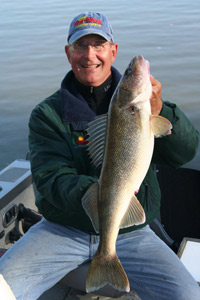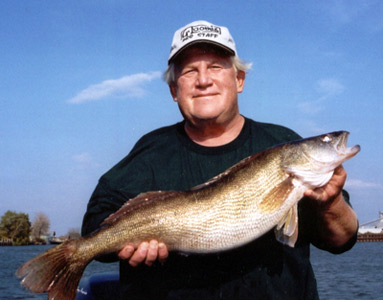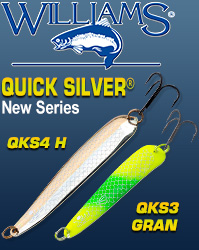Catching Lake Winnebago’s suspended walleyes
Gary Engberg Outdoor
If you have not fished Lake Winnebago, then you are missing out on one of Wisconsin’s premier walleye waters which seems to be just getting better and better every year. Lake Winnebago is the largest inland lake in the state of Wisconsin, encompassing 137,708 acres with a maximum depth of 21 feet. This breaks down to a lake that is approximately 30 miles long and 10 miles wide. If you include the Fox and Wolf Rivers, which are part of the Winnebago system, and the upper lakes of Butte Des Morts, Winneconne, and Poygan, we’re talking about more fishable waters than you could fish in an entire lifetime.
I’ve fished Lake Winnebago regularly for over two decades, and I have never had better fishing than in the last few years. You could always catch walleyes on ‘Bago, but for years one would struggle to catch legal or 15-inch fish. The entire system has its own walleyes that live there year-round, with spawning taking place in many areas from the Wolf River down to the main lake’s reefs and rocky west shoreline. The fish like to spawn in the upper marshes and work their way back to the main lake. But as I said, walleyes often stay in the upper lakes throughout the summer depending on the forage supply and water temperature.
Sometime in late May or early June, or when the water temperature reaches 60 degrees, many of the schools of fish move out into the big lake and on to the mud flats to feed on bugs and schools of forage fish. This spring, with the early warm weather, walleyes started spawning earlier than normal. The walleyes and their cousin, the sauger, roam this huge body of water from Menasha to Fond du Lac searching for food, which is their primary concern along with comfort.
 |
 |
| Bruce Samson of Minnesota with a nice walleye. | Author with a fine walleye. |
Some years back, Greg Horoky of Canada, while fishing an In-Fisherman Professional Walleye Trail tournament, unlocked a secret that holds true to this day. Horoky found schools of 3- to 5-pound fish suspended over the mud flats in the main lake. The fish that Greg was catching were only a few feet down over 18 to 20 feet. These fish weren’t even marked on the best electronics because they are so high up in the water column.
There is a relationship between the walleye and white bass. The white bass will attack schools of baitfish and stun them. Walleyes, being the opportunistic feeders they are, move in and take the easy pickings left by the white bass. These fish are so high in the water column because they are actively feeding on baitfish.
Another important factor is that Lake Winnebago did away with a size minimum some years ago, which, instead of hurting the lake’s population, helped it. Anglers were more than happy to take home some of those 13- and 14-inch fish, which put less pressure on the bigger fish and allowed some year classes to grow and spawn at least once.
The population of the lake’s fish has grown, and now there are plenty of fish between 18 and 22 inches. Kendall Kamke, the DNR biologist in Oshkosh, estimates that there are over a million walleyes longer than 15 inches in the Winnebago system. The daily bag limit is five walleyes with no minimum size limit. There are walleyes from the 1991, 1996, 1997, and 1998 spawns. Many spawns during the 2000s have contributed to the lake’s growing population.
Lake Winnebago has had a major walleye tournament every weekend in the month of June, and the weights bear this out. I’ve seen tourneys in the 1990s and early 2000s where 10 fish for a little over 20 pounds would put you in the money and the top 10. The Mercury Nationals and the Otter Street Tourney had winning weights of over 40 pounds for 10 fish. Over the second weekend in June, the winning weight at the Mercury Nationals was in the mid-40s for 10 walleyes.
During the last few years, I’ve spent more time in the upper lakes because that’s where the fish seemed to be early in the summer and late spring. This year, I’ve spent most of my time on the main lake, trolling the mud. I spent a weekend trying to catch some of the nonstop fish you can see on the bottom of the lake using electronics. I mean, you see fish everywhere, and I’m sure some of them are walleyes, but they are not biters.
Regularly, you have to run lines way up in the water column, using lures that run somewhere between 5 and 12 feet down in the water column. You can even run lures that go only 2 to 3 feet down over the deepest water and catch some of the biggest fish. The fish that I’ve been working are from Garlic Island all the way to Menasha. But, to catch these fish, you have to work them, constantly trying different lures at different speeds and varying the number of feet back that you run your lures. Never troll or pull in a straight line. Always troll or pull your baits, turning regularly, causing inside cranks to slow down and outside baits to speed up. This will sometimes trigger fish to hit.
Being a good troller on a big body of water like Winnebago means you have to be set up correctly for trolling. A large deep-V boat is a must because the wind can pick up on the lake and make it ugly. I had a Tracker Targa 2000, which is 20 feet long with a beam of 96 inches, when I tournament fished. This boat could take the roughest waters, including anything the Great Lakes could offer. My main motor is a Mercury Optimax 200 HP, but the important motor for trolling is the Mercury 9.9 HP four stroke kicker. Some anglers I know use a 15-horse kicker, but the 9.9 have been fine for me. The four stroke engine is great with little smoke or noise and great fuel economy.
Next, it’s important to have line counter reels (Daiwa 27G) and good long rods to get your baits away from the boat. Here, I use G. Loomis MBR941, which is a rod measuring 7 feet 10 inches with a fast tip and good lower strength for big fish. My line is Stren Easy Cast in green and 10- to 12-pound tests. I have never had a big walleye break this line, and it’s really good to work with.
The crankbaits that work well on the Winnebago system are no secret. I prefer Mann’s Stretch 5s and 10s and the Loudmouth Jerkbait. Other baits that work well are Shad Raps in # 4, 5, 8, and 9, Wally Divers, Salmo Hornets and Jr. Thundersticks. Colors change regularly, but black-chrome, blue-chrome, fire-tiger, and orange belly cranks seem to be best. But don’t be afraid to try any color.
The next important tool is inline planer boards. Off Shore Tackle makes by far the best board on the market. The boards allow you to get your lines farther away from the boat, and the tattle tail flag lets you know if you’re dragging a small fish or weed. The releases don’t slip or have to be double wrapped. Off Shore continually refines and updates its products to remain on the cutting edge of the fishing industry. In Wisconsin, if you’re fishing with a partner, you’re allowed six lines, so with planer boards, you can run six boards and really cover a lot of territory. Once you locate fish, you can cut down your trolling distance and zero-in on the aggressive fish.
The Lake Winnebago system is now a walleye angler’s dream, so try to get out and catch some good eaters and remember that high in the water column is where you’ll often find the better fish.
Contacts: Gary Engberg at 608.795.4208, Tony Puccio at 608.845.5410, Wally Banfi at 608.644.9832.









